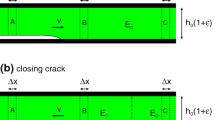Abstract
The forces controlling the slow growth of a crack through a system with time dependent elasticity are discussed. The geometry studied was that of thin film peeling, where a layer of polymer was detached from a rigid substrate under a constant load. Four forces resisting crack growth were necessary to explain the crack behaviour, two arising from surface effects and two from bulk relaxations. Experiments on the peeling of rubber from poly (methylmethacrylate) have supported the theory.
Résumé
On discusse des forces qui contrôlent la croissance lente d'une fissure dans un système dont les caractéristiques d'élasticité dépendent du temps. La géométrie étudiée est celle d'un film mince en cours de pelage, à savoir une couche de polymère se détachant d'un substrat solide sous un effort constant. Pour expliquer le comportement de la fissure, il a fallu recourir à quatre forces s'opposant à la croissance de la fissure, deux émanant d'effets de surface, et deux associées à des relaxations d'ensemble. Des essais de pelage d'un caoutchouc silastomère déposé sur du polyméthylméthacrylate ont confirmé la théorie proposée.
Similar content being viewed by others
References
A. A. Griffith, Phil. Trans. Roy. Soc., 221 (1920) 163.
N. F. Mott, Engineering, 16 (1948) 2.
A. S. Tetelman and A. J. McEvily, Fracture of Structural Materials, Wiley, New York, (1967) p. 50.
E. Orowan, Rep. Prog. Phys., 12 (1948) 185.
G. R. Irwin, Fracturing of Metals, A.S.M., Cleveland, Ohio (1948) p. 147.
J. W. Obreimoff, Proc. Soc. (Lond.), A27 (1930) 290.
E. Orowan, Zeit. Phys., 82 (1933) 239.
A. I. Bailey and J. S. Courtney-Pratt, Proc. Roy. Soc. (Lond.), A227 (1955) 500.
J. P. Berry, Nature, 185 (1960) 91.
J. J. Gilman, J. Appl. Phys., 31 (1960) 2208.
J. D. Burton, W. D. Jones and M. L. Williams, Trans. Soc. Rheol., 15 1 (1971) 39.
K. L. Johnson, K. Kendall and A. D. Roberts, Proc. Roy. Soc. (Lond.), A324 (1971) 301.
B. V. Deryagin and N. A. Krotova, Chem. Abs., 43 (1949) 2842.
K. Kendall, J. Phys. D.: Appl. Phys., 4 (1971) 1186.
P. B. Lindley, J.I.R.I., 5 (1971) 243.
N. A. Krotova, Y. M. Kirillova and B. V. Deryagin, Zhur. Fiz. Chim., 30 (1956) 1921.
K. Kendall, J. Adhesion, 5 (1973) 179.
J. I. Bluhm, Fracture, ed. H. Liebowitz, Academic Press, N.Y. (1969) p.2.
K. Kendall, in press.
K. Kendall, J. Adhesion, 5 (1973) 105.
Author information
Authors and Affiliations
Rights and permissions
About this article
Cite this article
Kendall, K. The dynamics of slow peeling. Int J Fract 11, 3–12 (1975). https://doi.org/10.1007/BF00034708
Received:
Revised:
Issue Date:
DOI: https://doi.org/10.1007/BF00034708




